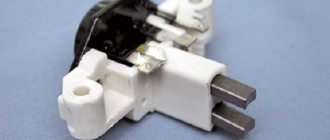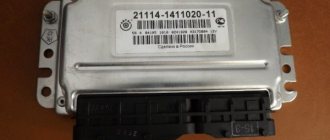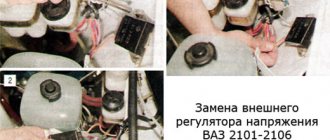- How does a voltage regulator work?
- Signs of regulator malfunction
- How to replace a voltage regulator
- Useful video
Many drivers have heard that the car has such a part as the VAZ 2114 voltage regulator, but they do not know what role it plays and what to do if it malfunctions. We will try to answer all these questions in today’s article.
Voltage regulator VAZ 2114
Three-level voltage regulator
Hello everyone, today I will tell you about the “three-level voltage regulator”.
From the moment I bought the car, the voltage in the on-board network constantly sagged and sagged quite a bit, in the summer it was normal, but frost came, I changed the battery every two weeks, it was completely discharged.
It was decided to take a working bush generator, install it and drive it. We installed it, the result is a little better, but the voltage in the on-board network still drains, especially when the rear heating is turned on.
Then I started scratching my... turnip =) After climbing around D2, I saw that almost everyone suffers from such garbage and I saw “three saving words” - this is a “three-level voltage regulator” from the manufacturer “Energomash”.
Armed with a pen and paper, I began to call the entire city of Voronezh in search of “TRN,” but after calling 30-40 stores and hearing in almost every store “We have them, but they sell out very quickly,” I almost lost hope in the search.
But still…
I found it in the BB store and it was the last one. I picked it up from the window.
Having installed “TRN” all the problems disappeared, namely:
Now I have it on MAX showing 14.8-14.7 at Bright Light. heater on, music and rear window heating
The joints have disappeared:
— The alarm began to open well in the mornings, before it was cold when I had to open it with a ruler.
— The low and high beams began to shine brighter. — All the light bulbs in the cabin and outside began to shine brighter. — The stove is in the first position, almost blows away the driver and passengers =) — The windows have become faster. — In the morning it starts the first time. — The battery is always charged!
I advise everyone! Put it on for 5 minutes!
Three-level voltage regulator for VAZ generator
Today, domestic cars have a serious problem with the rapid discharge of batteries. At the same time, their resource is rapidly running out, and new models on the market are expensive. The main reason for this is the frequent change of operating modes. In this case, little depends on the actions of the driver. In turn, the battery constantly requires different voltages to charge.
The installed regulator in the car is designed to solve this problem. By default, it is of the usual type with a fairly simple design. Overall, it is ineffective and does its job poorly. This is due to the fact that, regardless of the operating conditions of the battery, it supplies a constant voltage to the device. However, it is not able to take into account the ambient temperature, vehicle speed, and the amount of energy required. At the same time, a three-level voltage regulator is capable of optimizing the entire process.
Very often, many car enthusiasts complain about problems with the car battery: either it discharges quickly, or its charge is not enough for the full operation of some vehicle systems (for example, the headlights shine dimly), or something else. In principle, all these claims are completely justified, which means that the desire to increase the life of the battery while maintaining its reliability looks quite logical. A battery is not a cheap pleasure, and if it is not provided with proper care, it will quickly fail, which will result in new material waste. However, proper operation is not the only factor affecting the durability of the device; a sharp change in the vehicle’s operating modes has a much greater impact on its “health.”
But the point is this: the standard regulator, in most cases, is designed to maintain a constant voltage in the vehicle’s on-board network, but the speed of movement, the number of current consumers and air temperature indicators change all the time, which, accordingly, requires different charging voltages from the battery. In order to correct the voltage, and as a result, optimize the charging mode, a three-level voltage regulator was developed for VAZ 2010 generators.
Voltage regulator for VAZ 2114: purpose, cost and replacement procedure
The vehicle's electrical system is extremely important for its proper operation.
Electricity works from the very beginning: when you turn the key in the ignition switch of a VAZ car, the electric starter turns the crankshaft for the first time. But a car is not a wall clock in which the battery can be changed once every few months; a car battery needs constant recharging. This function is performed by a direct current generator, which takes part of the power from the engine to perform its work. But, like any complex unit, it can give certain errors, but so that the voltage spread does not exceed 0.1 - 0.3 V and the generator always has an output within 13 V, a special VAZ voltage regulator is installed. Today we will understand what its purpose is, its structure and possible problems in the operation of the car due to the relay.
Voltage regulator VAZ (Three-level)
How to find a fault
First of all, you need to check the battery charging, as well as the ground (contacts). It may be a simple matter of oxidation of the wires or terminals. But in frequent cases, the battery light comes on precisely when the generator or its parts are faulty.
The car generator is designed to measure the mechanical rotational power in the crankshaft and convert it into electrical power. With its help, the battery device is charged, and all energy consumers in the car are “powered”: the diagnostic system, the ignition system, the panel (on-board) computer. Poor charging of the VAZ 2114 battery, in the overwhelming majority, is precisely a malfunction of the generator or its components.
There are few downsides to this: the battery is completely discharged and, as a result, you stop on the highway. I replaced the battery and moved on. But if the level of output power is greater than declared, then in this case the entire electrical system of the machine may fail. And then the cost of repairs increases significantly. But all this can be foreseen when the battery light is constantly on.
It is possible to replace the entire generator as a whole, but it will be cheaper to change some of its components. But before we get into that, we need to check the fuses and the unit itself. If a problem is found in it, then it must be replaced.
PURPOSE AND TECHNICAL DEVICE
The voltage regulator relay has a specific task - to stabilize the current in the vehicle’s on-board network at the same level. In his work, he takes into account the following factors:
- Load on the network (total electricity consumption of already switched on devices);
- Temperature around the car and in the engine compartment;
- Rotor speed of the generating device.
The voltage regulator of the VAZ 2114 generator is also required to monitor the voltage that comes out of the generator in order to maintain the normal operation of all devices, since disturbances in the electrical network can provoke inaccurate sensor readings, at a minimum. Technically, it works like this: in the event of noticeable disturbances, it constantly monitors the current on the battery, and at the right moment simply turns off or turns on the voltage that is fed into the excitation winding of the generator itself.
Voltage control and stabilization - operation of the regulator
Generator failure - how to determine?
A breakdown of the generator entails big troubles - electrical appliances may fail and the battery life will be reduced. So, if the voltage regulator relay fails, the generator may produce a voltage greater than required. This can cause problems in the correct readings of electrical appliances, as well as in the operation of the car's lighting.
To independently check the functionality of the generator, you will need a tester and an assistant. First of all, insert the key into the ignition and start the car. The battery light on the dashboard should illuminate to indicate a low charge or an open circuit. It is necessary to warm up the car to operating temperature and turn on all possible devices in it.
Then take a tester and check the voltage at the battery terminals. During this time, your partner should keep their foot on the gas pedal and maintain 3000–3500 rpm of the engine. The voltage on the tester in a VAZ 2114 car with a normal working generator should be at least 12–13 Volts. If the voltage is less, it is necessary to proceed with a detailed check of the device. Urgent repairs are also required if the current is greater than 14.7 Volts. This applies not only to the VAZ 2114, but also to other passenger cars.
When checking the operation of the generator, you need to listen to its sound. The presence of a characteristic hum or noise from belt friction indicates wear of its bearing, in which case a complete repair of the device is necessary. Also, quite often the ground contact on the car’s generator turns out to be poor, because the wire is located quite low in the VAZ 2114. During rainy weather, water gets on it, which causes oxidation of the contact terminal.
Another reason for low voltage may be a tight or sufficiently worn alternator belt. As a result, the generator may not turn the required number of revolutions to maintain normal power supply. In this case, it is necessary to tighten it or replace it. The work of tightening or replacing the alternator belt will not take much of your time, and also does not require specific technical skills.
POSSIBLE PROBLEMS
If problems arise with the generator, for example, if the on-board voltage of the VAZ 2114 is low, then possible faults should be sorted out in the following sequence:
- Mechanical damage to the relay terminals;
- Oxidation of contacts;
- Complete absence or poor contact between the generator housing and the vehicle’s ground.
Therefore, if you have problems with the regulator, then the first thing you need to pay attention to is this terminal, which goes to ground.
Voltages must only be measured with the ignition on, or you will fail.
To make a correct comparison, you first need to measure the voltage at the positive terminal of the battery; it should be the same as at the regulator ground.
By the way, all electronic regulators that were invented back in Soviet times were free of most of these shortcomings. Their design was somewhat more perfect, but they were forgotten at one time and later moved away from their production.
PRICE CATEGORIES
To find out the cost of a voltage regulator for a VAZ 2114, it is advisable to simply go to the nearest car market and ask, the price range may vary. This factor is influenced by the type of components and the region in which the store is located.
Typically, the price of a two-level standard regulator, which is installed at the factory in the VAZ 2114 and their families, can range from 300 to 1200 rubles, here the reason for the fluctuation depends on the quality and the specific manufacturer; more reliable and high-quality options will always be somewhat more expensive than their low-quality counterparts. As for three-level models, their price starts from 1,500 rubles, but their productivity is much greater. During the purchase, it is advisable to immediately ask the seller to check the functionality so that there are no problems in the future.
THREE-LEVEL REGULATOR
Replacing the regulator with a new one in the event of a serious breakdown on your own is quite simple, the main thing is to install the brushes correctly. This option is also very common when drivers deliberately choose a three-level VAZ 2114 voltage regulator for their car. Its installation must be carried out correctly; here it is important to correctly rearrange the generator protective casing and switch the contacts on the terminals. It may be better to initially seek help from specialists so as not to damage the entire generator. Technically, it differs from a typical relay in that it has a more efficient voltage regulator that maintains the voltage at a stable level at all times, even under rapidly changing conditions. The factory has not yet come to install such a regulator, since this option is considered more expensive.
How does a voltage regulator work?
In terms of its design, the three-level voltage regulator VAZ 2114 is a relay with a transistor circuit and resistances connected to it, which, in turn, are connected to the exciting winding on the generator stator.
The principle of its operation is as follows - during its operation, the generator produces current with an unstable, intermittent voltage, the use of which directly in the on-board network could lead to malfunctions and even breakdowns of electronic equipment. In order to eliminate these surges and maintain the voltage produced by the generator at the same level, a stabilizer regulator is needed.
Operation of the voltage regulator VAZ 2114
So, when generating too high a voltage, the device includes additional resistors in the circuit, which lower the voltage to the desired level. Otherwise (when the voltage is too low), the stabilizer turns off all resistance in the circuit, and the voltage produced by the generator increases.
Speaking about the operation of the stabilizer, one should also take into account the fact that all these adjustment voltage fluctuations occur at a high frequency, as a result of which the total voltage in the on-board network remains virtually unchanged.
In simple terms, the voltage regulator of the VAZ 2114 generator is responsible for:
- activation of the electric generator;
- control of the current supplied by the generator;
- maintaining the voltage supplied to the on-board network at a stable level.
Voltage regulator location
For the regulator mounted on the 14th model, the standard operating parameters are a nominal voltage of 14.5 volts and a nominal current of 5 amperes.
REPLACING THE REGULATOR WITH A NEW OWNER ON YOUR OWN
Now we need to figure out how to replace the VAZ 2114 voltage regulator. First, you need to understand that it itself is located inside the generator housing. Mechanically, it consists of a special armature, an electromagnet and a relay. To disassemble the generator and remove the regulator we will need the following necessary tools:
- Set of open-end wrenches;
- Various screwdrivers.
Typically, repairs involve a complete replacement, but the generator itself does not need to be completely removed from the car. However, first you need to remember to remove the terminals from the battery, 12 V is not much, but it will be unpleasant to get hit. After the car has been de-energized, you need to remove the caps from the generator terminals and unscrew them with a screwdriver. Now you need to carefully remove the protective casing from the generator; on the VAZ 2114 it is equipped with spring latches; it is important not to break them right away. Now the voltage regulator of the VAZ 2114 generator will be visible under the casing; you need to unscrew its fastenings and pull it out of the seats along with the brushes.
The next phase of our work will be to check its functionality. Now let’s figure out how to understand that the voltage regulator is not working, for this we will need the following components:
- Accumulator battery;
- Miscellaneous wires;
- An ordinary 12 volt lamp, anything from the car's network will do.
You need to immediately understand that checking the regulator should be carried out only together with the brushes.
The light bulb itself must be connected via wires to the generator brushes; the polarity of the wires does not matter. Now you need to figure out where the negative terminal of the battery is and connect it to the relay body, and the second one must be connected to the regulator terminals. If everything is done correctly, the bright light from the light bulb will be a sure sign that all elements are working properly. You also need to know that testing the functionality of a new regulator is carried out in exactly the same way. After the repair is completed, everything must be assembled strictly in the reverse order, and it is advisable to charge the battery during the repair so that it does not lose its charge.
How to replace a voltage regulator
If during the test it turns out that the regulator is faulty, then you should replace it with a new one of a similar model as quickly as possible.
This should be done as follows:
- Disconnect both terminals from the battery.
- Disconnect the block with wires connected to terminal “D” of the generator.
- Remove the rubber cap from the “positive” terminal, using a 13mm wrench, unscrew the nut securing the bundle of wires to the stud.
- Remove the wires from the pin contact.
- Open the 3 plastic clips on the lid.
- Using a flathead screwdriver or narrow blade, remove the cover.
- Using a Phillips screwdriver, unscrew the 2 screws securing the regulator.
- Disconnect the wires leading to the device.
- Remove the regulator housing along with the graphite brushes.
Installing a new voltage regulator should be done in the same order, but in reverse order.
Replacing the voltage regulator VAZ 2114
When installing a new regulator, be sure to clean all its contact surfaces and check the tightness of the contacts. Otherwise, failures and incorrect operation of the device may occur.
Finishing the conversation about the voltage regulator, I would like to remind you once again that at the first sign of a malfunction of the device, you should replace it with a new one, since otherwise there is not only a risk of failure of the on-board electronics or increased fuel consumption, but also the likelihood of a short circuit with further fire cars.
Three-level voltage regulator for a car
Not long ago, I learned about a three-level voltage regulator and decided to install it on my car, since with a standard regulator, which is installed as standard, the battery is not fully charged, and you have to periodically recharge it from a charger.
Why do you need a voltage regulator?
The output voltage of the generator depends on the speed and current supplied to its rotor. If you connect power to the rotor and do not control it, then as the speed increases, the voltage at its output terminals can rise so much that all electrical consumers on the car burn out.
Since the engine speed varies over a wide range, the output voltage can only be controlled by changing the current in the rotor winding. This is exactly what a voltage regulator does. It monitors the voltage at the generator output and if it is higher than required, it reduces the pulse width supplied to the rotor winding, and vice versa increases the pulse width when the voltage decreases.
The standard voltage regulator (using the VAZ 2107 as an example) produces 13.6 volts. And if you turn on the load, it will sag and the battery will not be able to fully charge. It will need to be periodically recharged from a charger, otherwise its service life will decrease.
After starting the car, the battery needs to recover the energy it gave to the starter. To do this, the engine needs to run for a certain time. When the generator voltage decreases, this time increases. Therefore, when driving short distances from work to home, the battery cannot be restored.
Three-level voltage regulator VAZ 2114
With its help, you can change the voltage at the generator output within a small limit.
It is especially worth noting about devices with thermostats. The sensor is mounted on the battery case and allows you to regulate the voltage depending on the current temperature of the electrolyte in the battery banks. This significantly increases the battery life. Installation of three-level devices is simple. The difference from the standard one is the separation of the brush block and the main circuit of the device into different housings. Otherwise, the principle of operation is the same as that discussed above. But with a nuance - the voltage at the generator output changes depending on operating conditions. The operation of the three-level voltage regulator VAZ 2114 looks like this:
- The switch is in the minimum position. In this case, the voltage remains at 13.6 Volts. Ideal for use in summer, under conditions of high engine loads.
- The average value, also known as normal, allows you to maintain the voltage at 14.2 Volts. Relevant for work in the off-season - at temperatures of 0..20 degrees.
- And the maximum position is a voltage of 14.6 Volts, ideal for use in winter.
That's all that can be said about the three-level voltage regulator VAZ 2114; its installation is simple. It is enough to place a block with a switch on the body under the hood, and a brush holder on the generator instead of a standard regulator. Wires must be laid carefully, preferably secured with zip ties. And try to ensure that the contact with the ground is of high quality, otherwise the battery will discharge very quickly.











